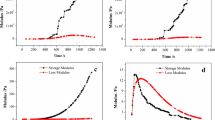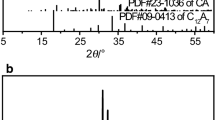Abstract
The present paper deals with the study of pH buffer influence (pH + ions) on hydration course of tricalcium aluminate (C3A), monocalcium aluminate (CA), monocalcium di-aluminate (CA2) and dodecacalcium hepta-aluminate (C12A7). These calcium aluminate phases were synthesized at 1450 °C (CA and C3A), 1600 °C (CA2) and 1360 °C (C12A7), respectively. The purity of synthesized products was controlled by X-ray diffraction (XRD). Then, different calcium aluminate phases were hydrated at 25 °C in excess of water at pH 6 and with buffers to keep the pH values at 9, 11 and 13. The evolution of hydration heat was monitored by isothermal calorimetry for 48 h. After this period, hydration was stopped and the products were cross-characterized with different techniques: XRD, high-temperature X-ray diffraction, combined differential thermal analysis–thermogravimetry–effluent gas analysis. It was found out that the hydration course and the nature of hydration products of different calcium aluminate phases are strongly dependent on the hydration environment (pH + ions).






Similar content being viewed by others
References
Pollmann H. Mineralogy and crystal chemistry of calcium aluminate cement. Calcium Alum Cem. 2001;2001:79–119.
Scrivener KL, Cabiron JL, Letourneux R. High-performance concretes from calcium aluminate cements. Cem Concr Res. 1999;29:1215–23.
Bensted J. Calcium aluminate cements. In: Bensted J, Barnes P, editors. Structure and performance of cements. 2nd ed. London: Spon Press; 2002.
Šoukal F, Brandštetr J, Havlica J. Macrodefect-free (MDF) cementy—review. Silika. 2007; 17:45–50.
Bensted J. High-alumina cement—present state of knowledge. Zem-Kalk-Gips. 1993;46:560–6.
Terzic A, Obradovic N, Andric L, Stojanovic J, Pavlovic V. Investigation of thermally induced process in corundum refractory concretes with addition of fly ash. J Therm Anal Calorim. 2015;119:1339–52.
Xu L, Wang P, Zhang G. Calorimetric study on the influence of calcium sulfate on the hydration of Portland cement–calcium aluminate cement mixtures. J Therm Anal Calorim. 2012;110:725–31.
Scrivener KL, Capmas A. 13—calcium aluminate cements. In: Hewlett PC, editor. Lea’s chemistry of cement and concrete. 4th ed. Oxford: Butterworth-Heinemann; 2003.
Scrivener KL. 2—calcium aluminate cements. In: Choo JNSCS, editor. Advanced concrete technology set. Oxford: Butterworth-Heinemann; 2003.
Bullard JW, Jennings HM, Livingston RA, Nonat A, Scherer GW, Schweitzer JS, Scrivener KL, Thomas JJ. Mechanisms of cement hydration. Cem Concr Res. 2011;41:1208–23.
Quennoz A, Scrivener KL. Interactions between alite and C3A-gypsum hydrations in model cements. Cem Concr Res. 2013;44:46–54.
Black L, Breen C, Yarwood J, Deng CS, Phipps J, Maitland G. Hydration of tricalcium aluminate (C(3)A) in the presence and absence of gypsum—studied by Raman spectroscopy and X-ray diffraction. J Mater Chem. 2006;16:1263–72.
Bohac M, Palou M, Novotny R, Masilko J, Vsiansky D, Stanek T. Investigation on early hydration of ternary Portland cement-blast-furnace slag-metakaolin blends. Constr Build Mater. 2014;64:333–41.
Meredith P, Donald AM, Meller N, Hall C. Tricalcium aluminate hydration: microstructural observations by in situ electron microscopy. J Mater Sci. 2004;39:997–1005.
Liu S, Wang L, Gao Y, Yu B, Bai Y. Comparing study on hydration properties of various cementious systems. J Therm Anal Calorim. 2014;118:1483–92.
Gawlicki M, Nocun-Wczelik W, Bak L. Calorimetry in the studies of cement hydration. J Therm Anal Calorim. 2010;100:571–6.
Xu L, Wang P, Zhang G. Formation of ettringite in Portland cement/calcium aluminate cement/calcium sulfate ternary system hydrates at lower temperatures. Constr Build Mater. 2012;31:347–52.
Pacewska B, Nowacka M. Studies of conversion progress of calcium aluminate cement hydrates by thermal analysis method. J Therm Anal Calorim. 2014;117:653–60.
Torréns-Martín D, Fernandéz-Carrasco L, Blanco-Varela MT. Thermal analysis of blended cements. J Therm Anal Calorim. 2015;121:1197–204.
Chotard T, Gimet-Breart N, Smith A, Fargeot D, Bonnet JP, Gault C. Application of ultrasonic testing to describe the hydration of calcium aluminate cement at the early age. Cem Concr Res. 2001;31:405–12.
Chotard TJ, Boncoeur-Martel MP, Smith A, Dupuy JP, Gault C. Application of X-ray computed tomography to characterise the early hydration of calcium aluminate cement. Cem Concr Comp. 2003;25:145–52.
Chotard TJ, Smith A, Boncoeur MP, Fargeot D, Gault C. Characterisation of early stage calcium aluminate cement hydration by combination of non-destructive techniques: acoustic emission and X-ray tomography. J Eur Ceram Soc. 2003;23:2211–23.
Chotard TJ, Smith A, Rotureau D, Fargeot D, Gault C. Acoustic emission characterisation of calcium aluminate cement hydration at an early stage. J Eur Ceram Soc. 2003;23:387–98.
Kudryavtsev AB, Kouznetsova TV, Linert W, Hunter G. A study of the hydration of aluminate minerals based on the measurements of the mean and the variance of the proton magnetic resonance relaxation rate. Chem Phys. 1997;215:419–27.
Kalina L, Másilko J, Koplík J, Šoukal F. XPS characterization of polymer-monocalcium aluminate interface. Cem Concr Res. 2014;66:110–4.
Garces P, Alcocel EG, Chinchon S, Andreu CG, Alcaide J. Effect of curing temperature in some hydration characteristics of calcium aluminate cement compared with those of Portland cement. Cem Concr Res. 1997;27:1343–55.
Georgescu M, Badanoiu A. The silica fume and temperature influence on the hydration and hardening processes of 12CaO center dot 7Al(2)O(3). Rev Roum Chim. 1999;44:25–30.
Gessner W, Moehmel S. Recent researches on calcium aluminate hydration. Calcium Aluminate Cem. 2001;2001:151–4.
Goske J, Pollmann H, Pankau HG. Hydration of high alumina cement investigations with low temperature SEM (cryo-technique). Calcium Aluminate Cem. 2001;2001:189–96.
Christensen AN, Jensen TR, Scarlett NVY, Madsen IC. Hydrolysis of pure and sodium substituted calcium aluminates and cement clinker components investigated by in situ synchrotron X-ray powder diffraction. J Am Ceram Soc. 2004;87:1488–93.
Jensen TR, Christensen AN, Hanson JC. Hydrothermal transformation of the calcium aluminum oxide hydrates CaAl2O4 center dot 10H(2)O and Ca2Al2O5 center dot 8H(2)O to Ca3Al2(OH)(12) investigated by in situ synchrotron X-ray powder diffraction. Cem Concr Res. 2005;35:2300–9.
Smith A, Chotard T, Gimet-Breart N, Fargeot D. Ultrasonic measurements as an in situ tool for characterising the ageing of an aluminous cement at different temperatures. J Eur Ceram Soc. 2002;22:2261–8.
Smith A, Chotard T, Gimet-Breart N, Fargeot F. Correlation between hydration mechanism and ultrasonic measurements in an aluminous cement: effect of setting time and temperature on the early hydration. J Eur Ceram Soc. 2002;22:1947–58.
Ukrainczyk N, Matusinovic T. Thermal properties of hydrating calcium aluminate cement pastes. Cem Concr Res. 2010;40:128–36.
Gosselin C, Gallucci E, Scrivener KL. Influence of self heating and Li2SO4 addition on the microstructural development of calcium aluminate cement. Cem Concr Res. 2010;40:1555–70.
Gotz-Neunhoeffer F. Kinetics of the hydration of calcium aluminate cement with additives. Zkg Int. 2005;25:65–72.
Li SQ, Hu JH, Liu B. Characterization of modified hydraulic calcium aluminate. Mater Res Innov. 2009;13:35–40.
Mohmel S, Gessner W. The influence of alumina reactivity on the hydration behaviour of mono calcium aluminate. Solid State Ionics. 1997;101:937–43.
Pastor C, Fernandez-Jimenez A, Vazquez T, Palomo A. Calcium aluminate cement hydration in a high alkalinity environment. Mater Construct. 2009;59:21–34.
Ukrainczyk N, Matusinovic T, Kurajica S, Zimmermann B, Sipusic J. Dehydration of a layered double hydroxide—C(2)AH(8). Thermochim Acta. 2007;464:7–15.
Guirado F, Gali S, Chinchon JS. Thermal decomposition of hydrated alumina cement (CAH(10)). Cem Concr Res. 1998;28:381–90.
Acknowledgements
The work has been supported by grant project no. GA13-41018S financed by Czech Science Foundation and by project Materials Research Centre at FCH BUT—Sustainability and Development, REG LO1211, with financial support from National Programme for Sustainability I (Ministry of Education, Youth and Sports of Czech Republic).
Author information
Authors and Affiliations
Corresponding author
Rights and permissions
About this article
Cite this article
Šoukal, F., Koplík, J., Ptáček, P. et al. The influence of pH buffers on hydration of hydraulic phases in system CaO–Al2O3 . J Therm Anal Calorim 124, 629–638 (2016). https://doi.org/10.1007/s10973-015-5190-z
Received:
Accepted:
Published:
Issue Date:
DOI: https://doi.org/10.1007/s10973-015-5190-z




